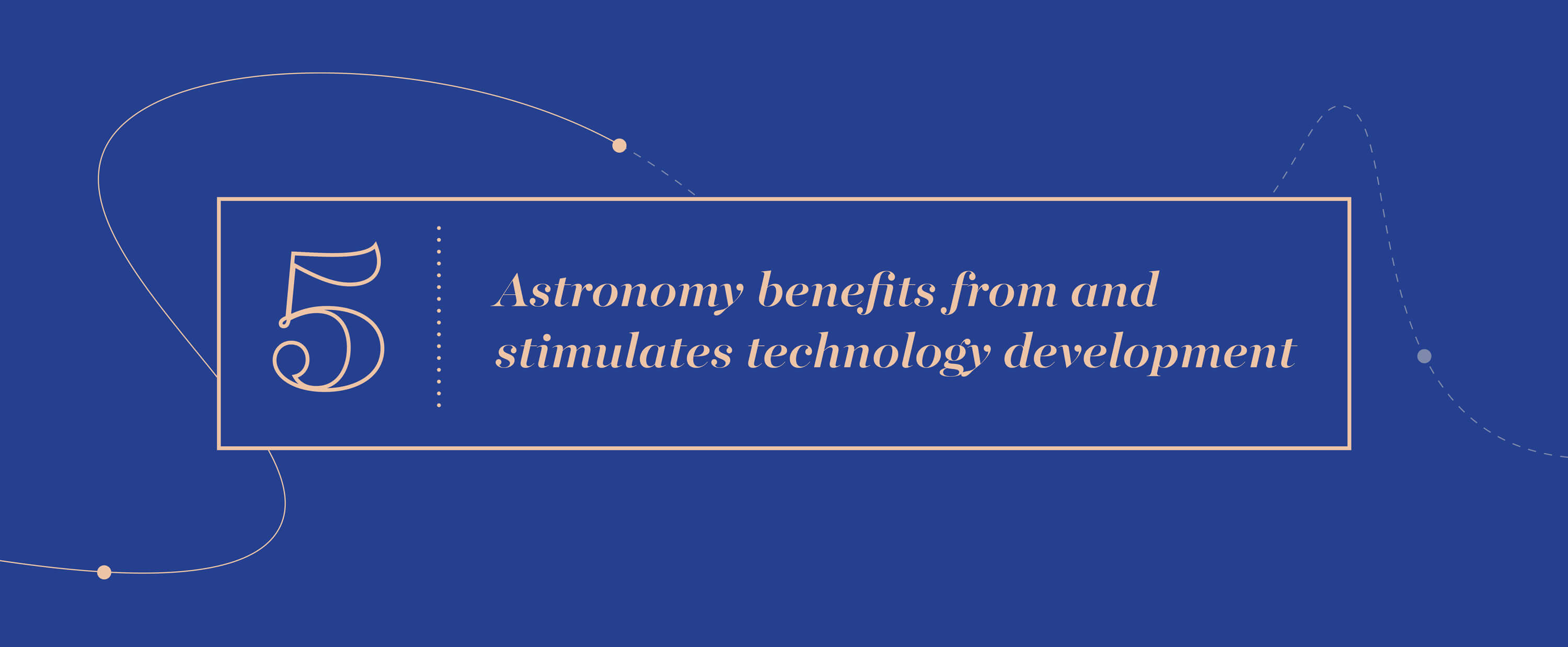
5.1
Telescopes and detectors are crucial to the study of Astronomy
Since electromagnetic waves are the main source of information in astronomy, telescopes and detectors play an important role when it comes to collecting and analysing these waves. Larger telescopes collect more light, allowing astronomers to identify and analyse very faint objects. Larger telescopes also have more resolving power, allowing astronomers to study their target objects in finer detail. While early astronomical observations were performed by looking directly through a telescope, detectors today allow astronomers to document their observations objectively, at many different wavelengths.
5.2
Some telescopes can be linked together to act as one big telescope
By linking together many telescopes, astronomers can make them work as a single big telescope using a technique called interferometry. The resolution of the combined instruments will be that of a single telescope with a diameter equal to the greatest distance between any two of the smaller, linked telescopes. This allows astronomers to see smaller and finer details in astronomical objects as well as distinguish between separate objects, such as a star and its planetary system.
5.3
Astronomical observatories are located on Earth and in Space
Earth’s atmosphere absorbs radiation from most of the electromagnetic spectrum. It is transparent to visible light, some ultraviolet and infrared, and shortwave radio, but otherwise mostly opaque. Most ultraviolet bands and large portions of infrared light, as well as X-rays, cannot penetrate the atmosphere. For this reason, most of the telescopes that collect light other than visible, radio and a smaller number of other wavelength bands, must be placed in space. Although visible light can be observed from the surface, the turbulence of Earth’s atmosphere affects the quality of the images, so some optical telescopes are also placed in space.
5.4
Earth-based astronomical observatories are often located in remote regions all around the world
Few locations on Earth provide the pristine observing conditions associated with high altitudes, an absence of light pollution, and transparency of the atmosphere to certain wavelengths. These locations can often be hostile, hard to access, and are usually far removed from larger human settlements. Astronomers either travel to those locations for their observations, allow experienced local telescope operators to carry them out for them, or make use of robotic telescopes, which are operated remotely.
5.5
Astronomy today is part of "Big Science" and “Big Data”
Astronomical surveys have started producing large amounts of data, and this will increase greatly in the coming years. This evolution is called “Big Data Astronomy”, where the focus is on finding novel ways to store, deliver and analyse these data. This has led to the development of various citizen science projects to tap into the acute pattern recognition ability of humans. On the other hand, modern telescopes and instruments are expensive, and their construction requires a variety of technical skills. In this era of “Big Science”, they are commonly constructed by international organisations or consortia involving numerous astronomical institutes from different countries.
5.6
Complex simulations and huge data in astronomy require the development of powerful supercomputers
The processing of vast amounts of data from both simulations and observations requires computers that are capable of performing complex simulations in a short amount of time. Current supercomputers can perform in the order of a couple of hundred quadrillion calculations every second. These supercomputers allow astronomers to create simulated Universes and compare them with observations from large-scale surveys.
5.7
Astronomy is a global science, with international teams, and where data and publications are shared freely
The data available from most professional observatories is publicly available. Over the course of their career, astronomers will typically work in different countries. Large astronomical projects, from the construction of telescopes and instruments to coordinated observing campaigns, are frequently undertaken in collaboration between researchers and institutes from different nations. Astronomy is global and international. We are all crew members of “Spaceship Earth”, under one sky, exploring the cosmos.
5.8
Numerous spacecrafts have been launched to space to study the Solar System
In order to explore and learn more about our place in the Universe, we have been sending robotic probes throughout the Solar System. Some of these probes orbit planets, moons, or even asteroids, while others have landed on such objects. Among some places in the Solar System that have been visited (landing, orbit or fly-by) by robotic probes are all the planets, the dwarf planets Pluto and Ceres, our Moon and other moons of Jupiter and Saturn, comets and asteroids.
